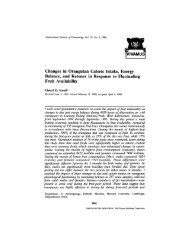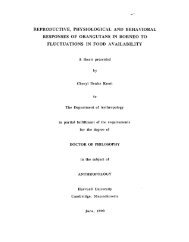Saving Gunung Palung: A Rainforest Marriage - Cheryl Knott
Saving Gunung Palung: A Rainforest Marriage - Cheryl Knott
Saving Gunung Palung: A Rainforest Marriage - Cheryl Knott
- No tags were found...
You also want an ePaper? Increase the reach of your titles
YUMPU automatically turns print PDFs into web optimized ePapers that Google loves.
the humanitiesThe Ninth Symphony:The Personal and the PoliticalBy Lewis LockwoodIn his new book, Beethoven: The Music and the Life (Norton), Lewis Lockwood setsout, among other biographical endeavors, to put the music of the world’s most famouscomposer into its historical—and personal—contexts. Lockwood, Fanny PeabodyProfessor of Music Emeritus at Harvard, is also the author of Beethoven: Studies in theCreative Process (Harvard, 1992) and was previously an editor of the journalBeethoven Forum. An excerpt from Beethoven follows. —Susan LumenelloTom KatesProfessor Emeritus LewisLockwood: Of all Beethoven’sworks, the Ninth Symphonyhas had the broadest impact.In 1998 at the Winter Olympics inNagano, Japan, Seiji Ozawaappeared in what may have been thelargest electronic simulation of a concerthall ever imagined. He conducted sixchoirs that were located in New York,Berlin, Cape Town, Sydney, Beijing, andNagano (six cities on five continents) ina televised simulcast in which all of themsang the “Ode to Joy,” the principaltheme of the finale of the Ninth Symphony,electronically synchronized toovercome time differences. Remarkableas this achievement was, it had a background.The “Ode” has been sung at everyOlympic Games since 1956. By the1990s it had become a common practicein Japan for massed choral groups andorchestras to come together in Decemberof each year to give performances ofDaiku—“The Big Nine.”The newly achieved world status ofthe “Ode to Joy” melody is only one ofthe most visible ways in which theBeethoven legend that was created in the19th century has been reshaped andenlarged many times over in the 20th.The very name Beethoven has attainedcult status beyond that of almost anyother classical composer; the cult hasspread through many levels of high,middle, and popular culture in music,art, television, and film. The Beethovenimage, now all too commercially viable,is itself the subject of a sizable literature.And no work has been more fertile increating and maintaining this imagethan the Ninth Symphony.Reprinted with permission from W.W. Norton & Company. Copyright2003 by Lewis Lockwood.In the mind of the general public thereare actually two “Ninth Symphonies.”One is the “Ode to Joy” itself, as choralanthem; that is, just the melody, not theelaborate and complex movement fromwhich it comes. The other is the symphonyas a complete work, a large-scale fourmovementcycle in which the enormousfinale brings solo and choral voices intothe symphonic genre for the first time. Seenas a whole, the movement plan of the workforms a progressive sequence in which thethree earlier movements balance eachother but also prepare the finale and give itmuch of its structural and aesthetic meaning.Beethoven’s setting of the first stropheof Schiller’s poem, beginning “Freude,schöner Götterfunken” (“Joy, beautifulspark of divinity”) is the admitted centerpieceof its finale, but it is matched in significanceby a second, contrasting sectionin a radically different style that sets thefirst chorus of the “Ode,” “Seid umschlungen,Millionen” (“Be embraced, you millions”).The theme and text of “Freude,schöner Götterfunken” is eventually combinedcontrapuntally with that of “Seidumschlungen, Millionen” to form the greatclimax of the movement. The “Seidumschlungen” theme has no chance whateverof being selected as a singable anthemby amateur choral groups because it ismelodically difficult and harmonicallyobscure, and is of a totally different typeand character. In other words, it is animportant feature of the modern history ofthe Ninth Symphony that at popular levelsit is barely known as a symphony atall but is represented only by its mostfamous melody.Harvard University6GSASTHE POLITICAL BACKGROUNDOF THE NINTHIn 1815, during the Congress of Vienna,perpetual spying was the order of the day,and police informers were everywhere.Artists such as Beethoven who wereknown for their republican views were suspect,and the Conversation Books (Editor’snote: After his hearing became severelydiminished, Beethoven used “conversationbooks” to communicate with peoplethrough written questions and remarks)reflect the atmosphere of suspicion thatruled the city. An 1820 entry that wasprobably made in a café says, “anothertime—just now the spy Haensl (Editor’snote: Lockwood notes that this is probablythe spy Peter Hensler) is here.” This situation,combined with Austria’s difficult economicrecovery, Beethoven’s personalfinancial reverses, and the disappearanceor death of many of his traditional aristocraticsupporters, fueled his habitualanxiety. When Dr. Karl von Bursy, recommendedby his old friend Amenda, visitedhim in June 1816, Beethoven ranted loudlyabout the state of things in Vienna:[V]enom and rancor raged in him.He defies everything and is dissatisfiedwith everything, blasphemingagainst Austria and especially Vienna.… Everyone is a scoundrel.There is nobody one can trust. Whatis not down in black and white is notobserved by anyone, not even by theman with whom you have made anagreement.





